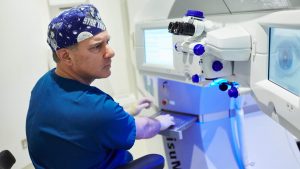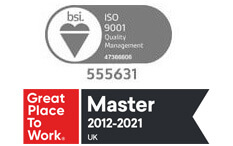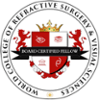The Five Most Common Myths About LASIK Laser Eye Surgery

LASIK (laser-assisted in-situ keratomileusis) is the most common Laser Eye Surgery carried out around the world today. It is less invasive than surface procedures like PRK and LASEK and more accessible than ReLEx SMILE; yet, a lot of misinformation continues to circulate regarding this incredibly safe and effective procedure, leading to the ongoing fear around the treatment. So, we want to address five of the more common myths about LASIK to set the record straight.
How Does LASIK Work?
LASIK involves state-of-the-art high-precision lasers that are used, first to create a flap in the cornea, and then to remove a pre-determined amount of tissue from the corneal bed. This allows your surgeon to reshape the eye and change how light is reflected onto the retina. This process corrects any previous refractive error, such as myopia (short-sightedness), hyperopia (long-sightedness) and astigmatism.
The clean and precise incisions created by the lasers during the procedure allow the corneal flap to be neatly repositioned, at which point healing can begin almost immediately. Since the inception of Laser Eye Surgery in the 1980s, outcomes and healing times have improved dramatically. This is largely thanks to the development of LASIK and the associated technology.
Debunking the Myths
The majority of patients who visit us at London Vision Clinic are suitable for LASIK. However, despite the high success rate and low prevalence of complications associated with treatment, we often have to debunk various myths quoted by our clients. Much of the misinformation around Laser Eye Surgery was initially spread by tabloid newspapers looking to flog sensational stories. But while this is increasingly uncommon, fear and anxiety persist.
A number of these ungrounded, out-of-date, or just plain inaccurate stories about LASIK surgery have spread through public thought to become full-blown industry myths and misconceptions. Our job is to straighten out the facts and make sure you are well-informed about the modern-day reality of LASIK surgery.
#1 – LASIK can cause blindness
This is arguably the most serious and fear-inducing myth surrounding Laser Eye Surgery. For most people, there are few things scarier than suddenly losing our sight. This is likely what has kept this extremely misinformed myth around for so long. So, let’s get to the bottom of it.
Technically speaking, Laser Eye Surgery could cause blindness. However, for this to happen, a series of very rare complications would all need to occur at once – and the likelihood of this happening? Well, it’s estimated to be around 1 in 5 million… Put in simple terms, this means that you are more likely to die from falling out of bed than you are to go blind from Laser Eye Surgery.
Furthermore, the risk of blindness posed by wearing contact lenses (which millions of people in the UK do every day), you may be over 30 times more likely to go blind.
#2 – Contact lenses are safer than LASIK
Contact lenses do not only increase your chances of going blind – they are also associated with a higher risk of other complications. Complications that are much less common as a result of LASIK surgery.
Many of the world’s leading eye physicians agree that daily wear of contact lenses over several years is a less safe way of restoring vision than LASIK.
Many factors, including wearing lenses for hours on end, failure to clean them properly, or not replacing them as directed, can lead to complications such as infection and impaired vision. This is often because contact lenses can restrict the supply of oxygen to the cornea which is essential for maintaining healthy eyes.
#3 – The long-term effects of LASIK are not known
Historically, there have been few long-term clinical studies on LASIK. This is partly due to its widely acknowledged safety and efficacy. However, the success of long-term outcomes of LASIK and other Laser Eye Surgery procedures are becoming increasingly well-known.
To date, this includes a LASIK follow-up study by Spanish researchers, published in 2008. The researchers tracked the results of LASIK on seventy patients over ten years and found that, overall, the patients’ corneas remained healthy and their vision stable.
Furthermore, in a 2021 review of the existing literature, assessing the long-term outcomes (with a minimum of 10 years) of LASIK in a total of 188 eyes, researchers concluded that both “PRK and LASIK carried out in the early days of medical excimer lasers have a very high level of safety and late complications occurred only rarely.”
Furthermore, the researchers noted that “due to technological improvements in hardware and software for both preoperative diagnostics and lasers, treatment performed nowadays is presumably even safer, more efficient and also more stable over a long period of time.”
#4: LASIK treatment is not permanent
Some patients may worry that the improvements they may experience following LASIK surgery will soon begin to reverse. After all, Laser Eye Surgery is not a cheap option for vision correction, so it’s good to know that you will be enjoying clear vision for the years to come.
Thankfully, LASIK surgery changes the composition of the eye and therefore makes a permanent adjustment to your vision.
The only way in which its results are compromised is through a process science is still yet to master: ageing. When we reach a certain age, our eyes, begin to deteriorate. Unfortunately, we can’t prevent this from happening, but we can maintain our youthful, glasses-free vision with PRESBYOND® Laser Blended Vision or a simple enhancement procedure.
#5: Side effects are common and serious after LASIK surgery
LASIK and other Laser Eye Surgery procedures can be associated with a number of side effects. However, these are usually not serious and resolve themselves in a matter of weeks.
Advancements in safety, technology, and expertise mean that today, the majority of patients experience little to no side effects from the procedure, with only a small number of patients experiencing mild but manageable side effects.
This can include light sensitivity, halos and starbursts, and dry eyes. Such symptoms may occur as a natural result of the eye’s recovery process. For most patients, they present a minor inconvenience for a couple of weeks. For example, in the case of dry eyes, these can be effectively managed with the help of lubricating eye drops.
Have any other doubts or concerns about Laser Eye Surgery? Don’t hesitate to get in touch with one of our patient care coordinators to learn more about LASIK and our other treatments at London Vision Clinic. Alternatively, Book a Consultation to start your journey to clear vision today.


